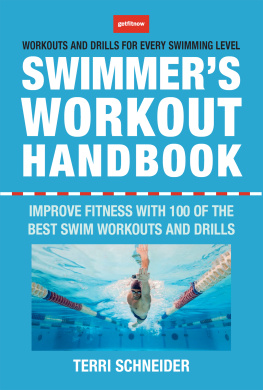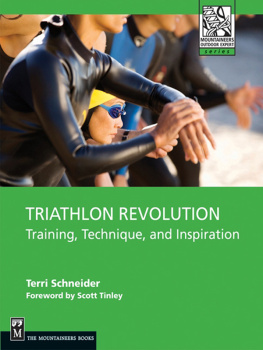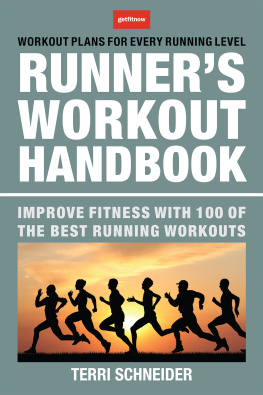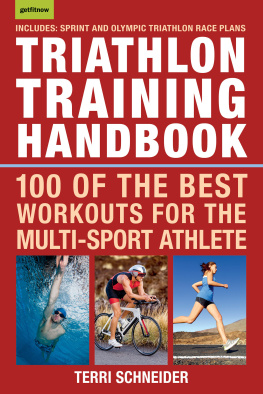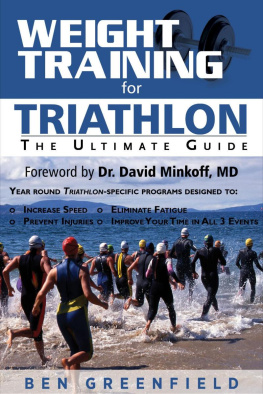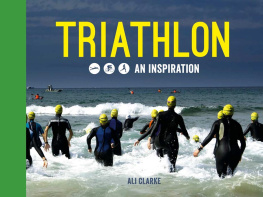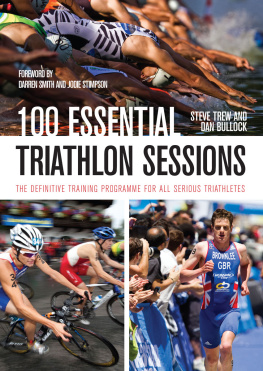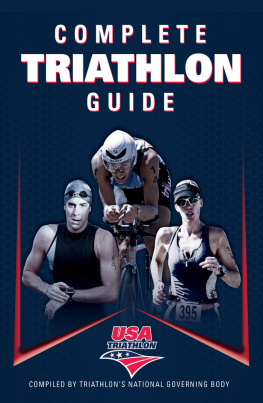Terri Schneider - Triathlon Training Handbook
Here you can read online Terri Schneider - Triathlon Training Handbook full text of the book (entire story) in english for free. Download pdf and epub, get meaning, cover and reviews about this ebook. year: 2018, genre: Home and family. Description of the work, (preface) as well as reviews are available. Best literature library LitArk.com created for fans of good reading and offers a wide selection of genres:
Romance novel
Science fiction
Adventure
Detective
Science
History
Home and family
Prose
Art
Politics
Computer
Non-fiction
Religion
Business
Children
Humor
Choose a favorite category and find really read worthwhile books. Enjoy immersion in the world of imagination, feel the emotions of the characters or learn something new for yourself, make an fascinating discovery.
- Book:Triathlon Training Handbook
- Author:
- Genre:
- Year:2018
- Rating:3 / 5
- Favourites:Add to favourites
- Your mark:
- 60
- 1
- 2
- 3
- 4
- 5
Triathlon Training Handbook: summary, description and annotation
We offer to read an annotation, description, summary or preface (depends on what the author of the book "Triathlon Training Handbook" wrote himself). If you haven't found the necessary information about the book — write in the comments, we will try to find it.
Triathlon Training Handbook — read online for free the complete book (whole text) full work
Below is the text of the book, divided by pages. System saving the place of the last page read, allows you to conveniently read the book "Triathlon Training Handbook" online for free, without having to search again every time where you left off. Put a bookmark, and you can go to the page where you finished reading at any time.
Font size:
Interval:
Bookmark:


 Your health starts here! Workouts, nutrition, motivation, community... everything you need to build a better body from the inside out! Visit us at www.getfitnow.com for videos, workouts,
Your health starts here! Workouts, nutrition, motivation, community... everything you need to build a better body from the inside out! Visit us at www.getfitnow.com for videos, workouts,nutrition, recipes, community tips, and more! Triathlon Training Handbook Text Copyright 2017 Terri Schneider Library of Congress Cataloging-in-Publication Data is available. ISBN: 978-1-57826-697-5 All rights reserved. No part of this book may be reproduced, stored in a retrieval system, or transmitted, in any form or by any means, electronic or otherwise, without written permission from the publisher. Book design by Carolyn Kasper Printed in the United States 10 9 8 7 6 5 4 3 2 1 Contents
 Benefits of Triathlon Training
Benefits of Triathlon Training  W hether you are a beginning endurance athlete working to increase your fun and fitness, or a veteran multi-sport athlete looking to add motivation and challenge into your training, the program and organized workout sessions in The Triathlon Training Handbook are for you. As a young girl I focused my sporting life mainly as a runner before expanding to multi-sport, but as an athlete and coach I have always believed that cross-training and multi-sport training offers us the most balance in our fitness program.
W hether you are a beginning endurance athlete working to increase your fun and fitness, or a veteran multi-sport athlete looking to add motivation and challenge into your training, the program and organized workout sessions in The Triathlon Training Handbook are for you. As a young girl I focused my sporting life mainly as a runner before expanding to multi-sport, but as an athlete and coach I have always believed that cross-training and multi-sport training offers us the most balance in our fitness program. After moving from triathlon to adventure racing and then focusing on ultrarunning, through and through I have cross-trained. Even while training for 100-mile or multi-day running events I have continued to add swimming, cycling, and strength training into my weekly regime. Why mix it up if my current goal is single sport racing or if I am not training for a triathlon event? Because I feel at my best both physically and mentally when I diversify my training. Consistent swimming of any sort will build your overall fitness as well as your upper body and core strength and is a fabulous non-weight-bearing activity. Cycling gets us out on the roads or trails while extending our cardiovascular fitness as well as total leg and hip strength. Running is an efficient and cost-effective means to gain fitness and as a weight-bearing activity that supports leg, foot, and ankle strength as well as increases cardiovascular efficiency, bone mass, and mental and emotional well-being.
The combination of all three placed into a safe and well crafted program of diverse training offers you wellness benefits beyond your wildest dreams while keeping the fun in your fitness. And if you have been looking to jump into the sport of triathlon or balance and mentally stimulate your current fitness, this handbook is for you. Studies have shown that even a minimal amount of endurance training per week will reduce tendencies toward anxiety, stress, and depression while increasing our quality of sleep and overall mood and mental focus. Benefits are best realized within the diversity in intensity, recovery, and distance within each session and within each week. This diversity of training, inclusive of recovery days, are three of the aspects that trigger our body to grow stronger, faster, and more proficient. Another important element is consistency of training over many weeks.
Incorporating all these training elements into a multi-sport program, as done in The Triathlon Training Handbook , offers a motivating and highly productive process. And if your goal is to toe the start line of a multi-sport event of any kind, The Triathlon Training Handbook will get you there. Stretching for Endurance Athletes Your weekly plan includes daily stretching. Stretching is useful for injury prevention, maintaining range of motion, and helping you connect with areas of your body that need attending. If you already incorporate a stretching or yoga program into your training routine continue to execute that program each day. If you are not currently stretching, start with doing the following stretches daily: Standing Spinal Twist: Stand with your hands clasping a tree, fence, or wall.
Slowly turn your lower body to the left, away from the fence, while maintaining your upper body position toward the fence. Keep your spin straight and long. Do the same on the right side. Standing Side Stretch: Stand with your feet shoulder-width apart. Raise both arms to the side and clasp them overhead while maintaining a straight spine and hips. Extend your clasped hands toward the sky and bend from the hips slightly to the right side.
With your arms continually extended, move through your center and bend to the other side. Standing Hamstring Stretch: Place one ankle on a raised object (the height of the object will be dependent on how flexible your hamstrings are). Only raise your leg to a height that allows you to feel a gentle stretch. Keep your pelvis in a straight line with your spine (do not tilt your pelvis). You may feel the stretch while remaining upright. If so, continue standing upright.
If you need more of a stretch, lean slightly forward while keeping your spine long and straight. Calf Stretch: Stand about three feet from a wall or fence, with your feet at shoulder-width, flat on the ground, and toes pointing forward. Put your hands on the fence with your arms straight for support. Lean your hips forward with a soft bend in your knees to stretch your calves. You can also do this stretch focusing on one leg at a time for more focused effect. Standing Quad Stretch: Stand on one foot, with one hand on an object for balance.
Hold the top of your foot with the opposite hand and raise the heel of the lifted foot to the buttocks (or as close as comfortably possible), stretching your quadriceps. Keep both knees close together with your spine and hips in a straight line throughout. Change legs and repeat on the other side.  General Terms and Guidance
General Terms and Guidance  Gear Requirements Goggles: Goggles not only protect your eyes in salt water or chemical-infused water, but they help you see clearly both above and below the water while swimming. Goggles need to fit your face and be comfortable to wear for long periods of time. If they are adjustable in the nose piece and head strap, you have a better chance of working them to prevent leaking or fogging.
Gear Requirements Goggles: Goggles not only protect your eyes in salt water or chemical-infused water, but they help you see clearly both above and below the water while swimming. Goggles need to fit your face and be comfortable to wear for long periods of time. If they are adjustable in the nose piece and head strap, you have a better chance of working them to prevent leaking or fogging.
Try them on in the store. If they hug your eye area with ease, make the purchase. You may need to try a few pairs before you find the brand that works best on your face. Swim cap: Your swim cap helps keep your head streamlined and insulated in the water and also keeps your hair out of your face. A popular choice is silicone. They are comfortable, longer lasting, and warmer than light-weight rubber swim caps, but they do cost a bit more.
Earplugs: Some would consider earplugs to be optional, but for a few reasons, all swimmers should wear them. When your ear is regularly exposed to excess moisture, water can remain trapped in your ear canal. The skin inside can become waterlogged, diluting the acidity that normally prevents infection. The soggy skin will also more readily allow bacteria to penetrate your skin. Bacteria and fungi from contaminated water can grow and cause swimmers ear, which is an infection of your outer ear and ear canal. All of the above can be prevented by using earplugs during your swimming workouts.
Font size:
Interval:
Bookmark:
Similar books «Triathlon Training Handbook»
Look at similar books to Triathlon Training Handbook. We have selected literature similar in name and meaning in the hope of providing readers with more options to find new, interesting, not yet read works.
Discussion, reviews of the book Triathlon Training Handbook and just readers' own opinions. Leave your comments, write what you think about the work, its meaning or the main characters. Specify what exactly you liked and what you didn't like, and why you think so.


